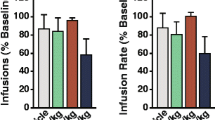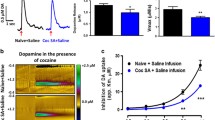Abstract
This experiment examined alterations in the ability of the highly selective 5-HT3 receptor agonist, 1-(m-chlorophenyl)-biguanide (mCPBG), to induce dopamine (DA) overflow in caudate brain slices obtained from rats withdrawn from continuous or intermittent cocaine administration. Rats were pretreated with 40 mg/kg per day cocaine for 14 days by either subcutaneous injections or osmotic minipumps, and then withdrawn from this regimen for 7 days. Caudate brain slices were obtained, and perfused with artificial cerebrospinal fluid. Following an equilibration period, the slices were then perfused with 25, 50, or 100 µM mCPBG. The samples were assayed for DA content by HPLC with electrochemical detection. The results indicated that the pretreatment with intermittent cocaine did not consistently alter the ability of mCPBG to induce DA overflow, although there was a reduction in the amount of DA released by the highest concentration of mCPBG. In contrast, pretreatment with continuous cocaine administration consistently and significantly attenuated the ability of mCPBG to induce DA overflow. The DA overflow induced by mCPBG was partially dependent on extracellular Ca2+ in the perfusion medium for the saline control and intermittent administration subjects: elimination of Ca2+ from the medium significantly reduced, but did not eliminate, DA overflow for these two groups. In contrast, elimination of Ca2+ from the perfusion medium had a significant enhancing effect on mCPBG-induced DA overflow in the continuous administration rats. These results suggest that distinct temporal patterns of cocaine administration differentially alter the ability of a 5-HT3 agonist to increase extracellular DA levels, and that this effect may be related to an impairment of Ca2+-dependent release. These results further suggest that 5-HT3 receptor subsensitivity may represent a partial mechanism for the tolerance following continuous cocaine administration.
Similar content being viewed by others
References
Benuck M, Reith MEA (1992) Dopamine releasing effect of phenylbiguanide in rat striatal slices. Naunyn-Schmiedeberger's Arch Pharmacol 345:666–672
Blandina P, Goldfarb J, Green JP (1988) Activation of a 5-HT3 receptor releases dopamine from striatal slice. Eur J Pharmacol 155:349
Blandina P, Goldfarb J, Craddock-Royal B, Green JP (1989) Release of endogenous dopamine by stimulation of 5-hydroxytryptamine3 receptors in rat striatum. J Pharmacol Exp Ther 251:803–809
Broderick PA (1991a) Cocaine: on-line analysis of an accumbens amine neuronal basis for psychomotor behavior. Pharmacol Biochem Behav 40:959–968
Broderick PA (1991b) In vivo voltammetric studies on release mechanisms for cocaine withγ-butyrolactone. Pharmacol Biochem Behav 40:969–975
Broderick PA (1992a) Cocaine's colocalized effects on synaptic serotonin and dopamine in ventral tegmentum in a reinforcement paradigm. Pharmacol Biochem Behav 42:889–898
Broderick PA (1992b) Distinguishing the effects of cocaine (IV) and (SC) on mesoaccumbens dopamine and serotonin release with chloral hydrate anesthesia. Pharmacol Biochem Behav 43:929–937
Broderick PA, Kornak EP, Eng F, Wechsler R (1993) Real time detection of acute (IP) cocaine-enhanced dopamine and serotonin release in ventrolateral nucleus accumbens of the behaving norway rat. Pharmacol Biochem Behav 46:715–722
Carboni E, Acquas E, Frau R, Di Chiara G (1989) Differential inhibitory effects of a 5-HT3 antagonist on drug-induced stimulation of dopamine release. Eur J Pharmacol 164:515–519
Carroll ME, Lac ST, Asencio M, Kragh R (1990a) Fluoxetine reduces intravenous cocaine self-administration in rats. Pharmacol Biochem Behav 35:237–244
Carroll ME, Lac ST, Asencio M, Kragh R (1990b) Intravenous cocaine self-administration in rats in reduced by dietary L-tryptophan. Psychopharmacology 100:293–300
Chen J, Van Parag HM, Gardner EL (1991) Activation of 5-HT3 receptor by 1-phenylbiguanide increases dopamine release in the rat nucleus accumbens. Brain Res 543:354–357
Chen J, Paredes W, Van Praag HM, Lowinson JH, Gardner EL (1992) Presynaptic dopamine release is enhanced by 5-HT3 receptor activation in medial prefrontal cortex of freely moving rats. Synapse 10:264–266
Costall B (1993) The breadth of action of the 5-HT3 receptor antagonists. Int Clin Psychopharmacol 8 [Supplement 2]:3–9
Costall B., Domeney AM, Naylor RJ, Tyers MB (1987) Effects of the 5HT3 receptor antagonist GR38302F on raised dopaminergic activity in the mesolimbic system of the rat and marmoset brain. Br J Pharmacol 92:881–890
Cunningham KA, Lakoski JM (1988) Electrophysiological effects of cocaine and procaine on dorsal raphe serotonin neurons. Eur J Pharmacol 148:457–462
Cunningham KA, Lakoski JM (1990) The interaction of cocaine with serotonin dorsal raphe neurons: single-unit extracellular recording studies. Neuropsychopharmacology 3:41–50
Cunningham KA, Asprodini EK, Bernau NA, Richard CA, Lakoski JM (1987) Enhanced inhibitory responses of serotonin neurons in the dorsal raphe nucleus (DRN) after repeated cocaine exposure. Soc Neurosci Abstr 13 [part 3]:1651
Cunningham KA, Paris JM, Goeders NE (1992) Chronic cocaine enhances serotonin autoregulation and serotonin uptake binding. Synapse 11:112–123
de la Garza R, Cunningham KA (1993) Effects of the 5-HT3 antagonist zacopride on the development and expression of cocaine sensitization. Poster presented at the 23rd Annual Meeting of the Society for Neuroscience, Washington DC
Falk JL, Fang M, Lau CE (1991) Chronic oral cocaine self-administration: Pharmacokinetics and effects on spontaneous and discriminative motor functions. J Pharmacol Exp Ther 257:457–465
Gardner EL (1992) Brain reward mechanism. In: Lowinson JH, Ruiz P and Millman RB (eds) Substance abuse: a comprehensive textbook. Williams and Wilkins, Baltimore, Md., pp. 70–99
Hagan RM, Jones BJ, Jordan CC, Tyers MB (1990) Effects of 5-HT3 receptor antagonists on responses to selective activation of mesolimbic dopaminergic pathways in the rat. Br J Pharmacol 99:227–232
Hamon M (1991) 5-HT3 receptors are critically involved in 5-HT/DA interactions. Biol Psychiatry 29:107S
Imperato A, Angelucci L (1989) 5-HT3 receptors control dopamine release in the nucleus accumbens of freely moving rats. Neurosci Lett 101:214–217
Imperato A, Puglisi-Allegra S, Zocchi A, Scrocco MG, Casolini P, Angelucci L (1990) Stress activation of limbic and cortical dopamine release is prevented by ICS 205–930 but not by diazepam. Eur J Pharmacol 175:211–214
Izenwasser S, Cox BM (1992) Inhibition of dopamine uptake by cocaine and nicotine: Tolerance to chronic treatments. Brain Res 573:119–125
Jiang LH, Ashby CR, Kasser RJ, Wang RY (1990) The effect of intraventricular administration of the 5-HT3 agonist 2-methylserotonin on the release of dopamine in the nucleus accumbens: an in vivo chronocoulometric study. Brain Res 513:156–160
Joyner C, King G, Lee TH, Ellinwood EH Jr (1993) A technique for the continuous infusion of high doses of cocaine by osmotic minipump. Pharmacol Biochem Behav 44:971–973
Kalivas PW, Duffy P (1988) Effects of daily cocaine and morphine treatment on somatodendritic and terminal field DA release. J Neurochem 50:1498–1504
Kalivas PW, Duffy P (1990) Effect of acute and daily cocaine treatment on extracellular dopamine in the nucleus accumbens. Synapse 50:48–58
Kalivas PW, Duffy P, Dumars LA, Skinner C (1988) Behavioral and neurochemical effects of acute and daily cocaine administration in rats. J Pharmacol Exp Ther 245:485–492
Kilpatrick GJ, Butler A, Burridge J, Oxford AW (1990) 1-(m-Chlorophenyl)-biguanide, a potent high affinity 5-HT3 receptor agonist. Eur J Pharmacol 182:193–197
King GR, Joyner C, Kee T, Kuhn C, Ellinwood EH Jr (1992). Intermittent and continuous cocaine administration: residual behavioral states during withdrawal. Pharmacol Biochem Behav 43:243–248
King GR, Kuhn C, Ellinwood EH Jr (1993a) Dopamine efflux during withdrawal from intermittent or continuous cocaine. Psychopharmacology 111:179–184
King GR, Joyner C, Lee TH, Ellinwood EH Jr (1993b) Withdrawal from continuous or intermittent cocaine: effects of NAN-190 on cocaine-induced locomotion. Pharmacol Biochem Behav 44:253–262
King GR, Joyner C, Ellinwood EH Jr (1993c) Withdrawal from continuous or intermittent cocaine. behavioral responsibility to 5-HT1 receptor agonists. Pharmacol Biochem Behav 45:577–587
King GR, Joyner C, Ellinwood EH Jr (1994). 5-HT3 receptor modulation of behavior during withdrawal from continuous or intermittent cocaine. Pharmacol Biochem Behav 47:339–407
Lane JD, Pickering CL, Hooper ML, Fagan K, Tyers MB, Emmett-Oglesby MW (1992) Failure of ondansetron to block the discriminative or reinforcing stimulus effects of cocaine in the rat. Drug Alcohol Depend 30:151–162
Lau CE, Imam A, Fang M, Falk JL (1991) Acute effects of cocaine on spontaneous and discriminative motor functions: relation to route of administration and pharmacokinetics. J Pharmacol Exp Ther 257:444–456
Lau CE, Falk JL, King GR (1992) Oral cocaine self-administration: relation of locomotor activity to pharmacokinetics. Pharmacol Biochem Behav 43:45–51
Ng JP, Hubert GW, Justice JB Jr (1981) Increased stimulated release and uptake of dopamine in nucleus accumbens after repeated cocaine administration as measured by in vivo voltammetry. J Neurochem 56:1485–1492
Paris JM, Cunningham KA (1990) Serotonin 5-HT3 antagonists do not alter the discriminative stimulus properties of cocaine. Psychopharmacology 104:475–478
Peltier R, Schenk S (1991) GR38032F, a serotonin 5-HT3 antagonist, fails to alter cocaine self-administration in rats. Pharmacol Biochem Behav 39:133–136
Peroutka SJ, Schmidt AW, Sleight AJ, Harrington MA (1990) Serotonin receptor “families” in the central nervous system: an overview. In: Whitaker-Azmitia PM, Peroutka SJ (eds) The neuropharmacology of serotonin. Annals of the New York Academy of Sciences, New York, pp 104–113
Pettit HO, Hwai-Tzong P, Parsons LH, Justice JB Jr (1990) Extracellular concentrations of cocaine and dopamine are enhanced during chronic cocaine administration. J Neurochem 55:798–804
Post RM, Contel NR (1983) Human and animal studies of cocaine: Implications for development of behavioral pathology. In: Creese I (ed) Stimulants: neurochemical, behavioral, and clinical perspectives. Raven Press, New York, pp. 169–203
Reith MEA (1990) 5-HT3 receptor antagonists attenuate cocaine-induced locomotion in rats. Eur J Pharmacol 186:327–330
Reith MEA, Sershen H, Allen DL, Lajtha AA (1982) A portion of [3H] cocaine binding in brain is associated with serotonergic neurons. Mol Pharmacol 23:600–606
Reith MEA, Benuck M, Lajtha A (1987) Cocaine disposition in the brain after continuous or intermittent treatment and locomotor stimulation in mice. J Pharmacol Exp Ther 243:218–287
Schechter MD (1993) Cocain discrimination is attenuated by isradipine and CGS 10746B. Pharmacol Biochem Behav 44:661–664
Schmidt CJ, Black CK (1989) The putative 5-HT3 agonist phenylbiguanide induces carrier-mediated release of [3H]-dopamine. Eur J Pharmacol 167:309–310
Svingos AL, Hitzemann R (1992) 5-HT3 receptor antagonists block cocaine-induced locomotion via a PCPA-sensitive mechanism. Pharmacol Biochem Behav 43:871–879
Tricklebank MD, Singh L, Loes RJ, Preston C, Iverson SD (1989) The behavioural effects of MK-801: a comparison with antagonists acting non-competitively and competitively at the NMDA receptor. Eur J Pharmacol 167:127–135
Tyers MB (1990) 5-HT3 receptors. In: Whitaker-Azmitia PM, Peroutka SJ (eds) The neuropharmacology of serotonin. The New York Academy of Sciences, New York, pp 194–205
Yakel JL, Shao XM, Jackson MB (1990) Desensitisation and modulation of the 5-HT3 receptor of NG108-15 cells. Neurosci Lett Suppl 38:S118
Yakel JL, Shao XM, Jackson MB (1991) Activation and desensitization of the 5-HT3 receptor in a rat glioma X mouse neuroblastoma hybrid cell. J Physiol 436:293–308
Author information
Authors and Affiliations
Rights and permissions
About this article
Cite this article
King, G.R., Xue, Z., Calvi, C. et al. 5-HT3 agonist-induced dopamine overflow during withdrawal from continuous or intermittent cocaine administration. Psychopharmacology 117, 458–465 (1995). https://doi.org/10.1007/BF02246219
Received:
Revised:
Issue Date:
DOI: https://doi.org/10.1007/BF02246219




